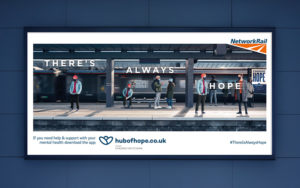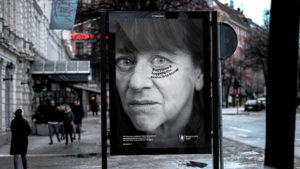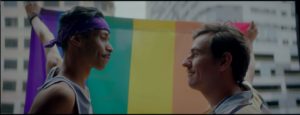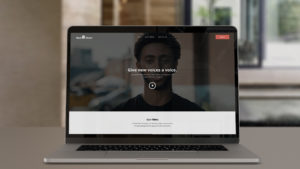Diverse voices at six independent agencies within Worldwide Partners – one of the largest and fastest-growing networks of independent marketing services agencies in the world – tell of their experiences working on powerful campaigns that have delivered social change in their own geographic, cultural, political and economic contexts.
From Canada to Vietnam, through Brazil, Sweden and the UK, these campaigns empower and enable change and are firing up the imagination of new blood in the independent agency network.
We let the talent tell their own stories…
There is Always Hope – UK
Campaign Name/Agency: There is Always Hope by Ardmore, Belfast
Client: Network Rail and mental health charity Chasing the Stigma
Glenn Irwin, senior creative, Ardmore

Talk us through the campaign…
The purpose of this campaign is to prevent people from taking their own lives on the railway – sadly, an ongoing challenge that the rail industry faces.
In 2019, 283 people died by suicide on the railway, up from 271 the year before. Despite the limited number of passengers and rail services throughout the Coronavirus pandemic, people are still making their way to the railway to end their lives, with this number steadily increasing as the restrictions around lockdown begin to ease.
Modern research into the psychology of railway suicide showed there could be value in exploring the principles of dissuasion. In other words, tackling the appeal of the railway as a place to end your life by dissuading people from going there in that frame of mind.
This approach acts as an early intervention and eventual signposting towards support services rather than when they are at crisis point on the railway.
We wanted to build strong associations of hope, connection and care with the railway – the aim being to subliminally connect with those at risk and dissuade them from the idea of railway suicide in the first place.
Who was the campaign aimed at?
The campaign primarily targeted men aged 18-55, as the group most likely to die from suicide. However, the messaging, creative and media strategy acknowledged that mental health and suicide is an issue that affects everyone.
Where did it run?
To reach the right people at the right time, our media strategy combined broad reach and interest-based targeting against key profile criteria such as music, sport, gambling and technology. Through a campaign partnership with charity partner, Chasing the Stigma, we signposted people to their mobile app, Hub of Hope, which provides people with access to local mental health support in their area. The main collateral is a film, which ran through broadcast television and online.
What was the impact?
The campaign was launched in March 2021. Initial audience tracking after the first month found: 43% of respondents now see the railway in a more positive light; 35% now think differently about the railway; and more than 29% have taken initial action, such as visiting the Hub of Hope website. In addition, 73% of respondents believe Network Rail is supporting Mental Health, strengthening the brand’s reputation.
The Dynamic Blood Appointment – UK
Campaign Name/Agency: The Dynamic Blood Appointment by 23red, London
Client: NHS Blood and Transplant
Anna Patteson, senior account manager, 23red

Talk us through the campaign…
Every day, thousands of people’s lives are saved or improved thanks to the generosity of blood donors. But NHS Blood and Transplant still needs 5,000 blood donors every day to make sure hospitals have the right supply. We needed to create a sense of urgency with a behaviour-change campaign to encourage people to donate now.
Time and convenience are the key barriers to donating, so if we could let people know how many appointments were available today and how close their nearest blood donor centre was, then we could hope to overcome these barriers.
We developed a series of striking portraits of real-life blood recipients by renowned photographer Dylan Collard to illustrate the people who would benefit from blood donations, mirroring the demographic makeup of the area. The portraits were paired with information around how many people had booked to give blood that day, or week, where their nearest donor centre was, and how many appointments were available.
Who was the campaign aimed at?
The campaign was aimed at new donors in local areas where an increase in blood donation was required. This meant that some areas were targeted based on rare blood types.
Where did it run?
Through a strategic media partnership with Clear Channel, we plugged into a network of over 100 dynamic digital out of home sites on high streets across England, in close proximity to permanent blood donor centres. Our data specialists worked with Clear Channel and anonymised data from NHSBT to create a dynamically updated system, making people aware of the volume of appointments available that day or week at their nearest donor centre.
What was the impact?
We saw a 33% increase in registrations overall compared to 20 days prior, a 42% increase compared to a period with no paid media running live and a 22% increase year on year.
No Excuses – Sweden
Campaign Name/Agency: No excuses by Blomquist Communication, Stockholm
Client: City of Stockholm
Stina-Marie Olsson, junior creative, Blomquist Communication

Talk us through the campaign…
Violence in close relationships and honour-based violence are huge problems in Sweden. That’s why the City of Stockholm opened four Relationship Violence Centres that offer treatment for victims and perpetrators of violence.
The purpose of this campaign was to encourage people to talk about violence, provide advice and tips on what you should do if you are worried that someone close to you is a victim of violence or perpetrating it, and signpost people to support services.
Feelings of guilt often become excuses. So we focused on challenging these excuses in the headlines: “He told me to shut up, but I just wanted to talk about it”, “Sometimes I see red and I don’t know why” and “Apparently he is this way because of his upbringing”.
Who was it aimed at?
“No excuses” was aimed at people in Stockholm who have been abused, are abusers, or who knows someone that might be abused. The abuse can take any form – physical, phycological, sexual, or financial. It was also aimed towards the wider citizens of Stockholm, the employees of the City of Stockholm, and partners within the social sector.
Where did it run?
The campaign ran on several different channels: social media platforms such as Snapchat, Instagram and Facebook, DOOH, and OOH in the subway. We also ran the campaign through influencers on Instagram.
What was its impact?
The exponential impact from the campaign came through our many different channels and generated a lot of discussions. Sveriges Radio, the public service radio in Sweden, talked about the campaign and its message. Influencers got their audience talking by sharing personal stories or anecdotes about abuse. The Snapchat lens was used and shared by millions. All spreading the message that there are no excuses for domestic violence.
Ngung Tao Nghiep (Don’t Cause Karma) – Vietnam
Campaign Name/Agency: Ngung Tao Nghiep (Don’t Cause Karma) by LeBros
Client: USAID, CITES Management Authority of Vietnam, Ministry of Agriculture & Rural Development & Tetra Tech.
Le Quoc Anh, senior copywriter, LeBros

Talk us through the campaign…
The purpose of this campaign was to discourage the personal use of elephant ivory and pangolin scales as displays of social status and wealth.
The target audience of this campaign is historically fixated on the belief that the use of these exotic products generates high social status – they do not feel guilt or remorse when these animals are killed. These adequately-educated people are not oblivious to the countless anti-usage campaigns, but they do not respond to the painful imagery of mistreated animals or the hard facts about the impact of poaching elephants and pangolins on the local ecosystem. Previous campaigns have fallen into this trap.
To channel this insight, our campaign drew on our target audience’s need to preserve their social image. It focused on their lingering fear of being judged negatively by their peers – the idea that, instead of gaining social status, their decision to use these products may lead to condemnation and shaming.
To bring this fear to life through traditional scare tactics, we created our own “mascot”, Mr Karma, as a manifestation of the threat of condemnation. Through the use of this persona, we depicted the user’s guilt and fear literally following them, making a mark on their bodies as a stamp of shame for all their peers to see.
Who was the campaign aimed at?
The campaign was mostly targeted at men between the ages of 30-55, who are statistically the primary users of products made from elephant ivories and pangolins in Vietnam. These people believe social wealth and good fortune stem from the possession of products made from elephant ivories and pangolin.
Where did it run?
The campaign kicked off with two situational films featuring Mr. Karma haunting a woman who bought an ivory bracelet, and a man who ate pangolin soup. The video was then adapted into different versions to run on social media sites (Facebook, YouTube) and LCD monitors in office buildings.
We used the campaign creative to lead our viewers to a microsite, where they could create and share their own personalised photos, which includes anti-usage messages. We approached many corporations, journalists, and celebrities in Vietnam to sign a pact against the usage of pangolin and elephant products to generate a wider sense of social shame.
What was the impact?
The two videos amassed 1.7 million views in 1 month, reached 364,000 users and engaged 74,000 people throughout the campaign. There were 120,000 views of campaign PR articles and 15 million people were reached across our OOH channels.
The campaign was among the most engaged social campaigns between the end of 2020 and beginning of 2021.
We Will Survive – Brazil
Campaign Name/Agency: We Will Survive by Propeg, Salvador, Bahia
Client: Gay Group of Bahia
Winerã Rabelo, junior art director, Propeg

Talk us through the campaign…
With the Covid-19 breakout, many LGBTQIA+ had to go back to their relatives’ homes in order to be protected from the virus. Unfortunately, instead of safety and sanctuary, what many of these people found was prejudice, intolerance and violence from their families.
The objective of this campaign was a call to action and to raise awareness of the 19th Gay Pride Parade, a yearly event promoted by the Gay Group of Bahia, Brazil’s first LGBTQ+ NGO. In 2020, the parade had to be held virtually.
To develop the detailed insights required, we conducted a series of interviews with the LGBTQI+ community about how the pandemic was unfolding for them. It was through this data that the creative team could see the problem through the eyes of the community and translate their fight into an ad that could grab the attention of the entire society.
The casting was very important. We had to find people engaged with the cause who could bring emotion into the film. The soundtrack was chosen because it’s a “hymn” for the LGBTQIA+ community and also a song that shows the human capacity of overcoming challenges, surviving and reinventing.
Who was the campaign aimed at?
The most important thing was to keep the fight alive, even if virtually. That’s why the film was targeted not only at the LGBTQIA+ community but at everyone who wanted to participate in this manifesto for life and the love for freedom during social isolation.
Where did it run?
The campaign was aired mainly on YouTube and Social Networks.
What was the impact?
The campaign had press coverage and won awards here in Brazil and certainly raised awareness of the 19th Gay Pride Parade in the way that we’d hoped it would.
Give New Voices a Voice – Canada
Campaign Name/Agency: Give New Voices a Voice by Fuse Create, Toronto
Client: Reel Start
Vanessa Francone, marketing & PR manager, FUSE Create
Talk us through the campaign…
To establish public awareness of Reel Start, a non-profit organisation whose mission is to empower underrepresented youth through the power of film, we put viewers in the shoes of the marginalised storytellers fighting for a chance to be heard. In “Give New Voices a Voice,” we interviewed the students of Reel Start about their love of film and their aspirations – but we silenced their answers. By muting their voices, we illustrated the struggles they face every day and made viewers feel their frustration.
In two follow-up videos, we turned the audio back on to reveal the students’ answers, providing a glimpse of the incredible talent the world will miss out on if we don’t give these kids a voice. The videos were deployed in sound-on digital and social environments, including Instagram Stories and YouTube, to maximise the impact of the audio portion of the story.
The content sent a clear message to the film world: ignoring these new voices of under-represented youth not only deprives them of life-changing opportunities but also deprives audiences of the incredible, diverse stories that make cinema so vital. After setting up these stakes, we showed them the solution: support Reel Start – and open the door for the diverse young storytellers who are waiting for their chance to shine.
Who was the campaign aimed at?
Our primary target was Canadians and Americans aged 30-55 who are passionate about film and align with the typical donor demographic – they have more disposable income than average and a desire to do something meaningful with it.
As our secondary audience, we targeted influencers within the film industry who already command considerable public attention and who know first-hand how hard it is for diverse young storytellers to break into the industry.
Where did it run?
The campaign had a North American focus, but the videos were viewed worldwide. The films were posted organically on Reel Start’s Instagram (stories and in-feed), Facebook, Twitter, LinkedIn and YouTube pages. The posts drove to Reel Start’s newly designed website for more information about the organisation.
What was the impact?
We generated huge awareness, grew a follower base on Instagram, and dramatically increased site traffic for Reel Start, all with zero paid media. The impact was felt through the viral nature of the engagement as the videos were shared, talked about, and viewed across channels and borders.
In just four weeks, the video campaign generated these results: 52.4 million impressions; 35.4 million people reached; brand Mentions up by 5,636%; 8,492 social media engagements; a 4,500% site traffic increase; and a five-fold increase in Instagram followers.
campaignlive.co.uk

